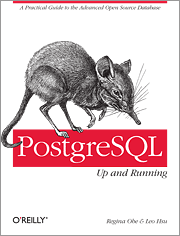Our new book PostgreSQL: Up and Running is officially out. It's available in hard-copy and e-Book version directly from O'Reilly, Safari Books Online and available from Amazon in Kindle store. It should be available in hard-copy within the next week or so from other distributors.
Sadly we won't be attending OSCON this year, but there are several PostgreSQL talks going on. If you are speaking at a talk or other PostgreSQL related get together, and would like to give out some free coupons of our book or get a free e-book copy for yourself to see if it's worth effort mentioning, please send us an e-mail: lr at pcorp.us .
Our main focus in writing the book is demonstrating features that make PostgreSQL uniquely poised for newer kinds of workflows with particular focus on PostgreSQL 9.1 and 9.2. Part of the reason for this focus is our roots and that we wanted to write a short book to get a feel for the audience. We started to use PostgreSQL in 2001 because of PostGIS, but were still predominantly SQL Server programmers. At the time SQL Server did not have a spatial component that integrated seamlessly with SQL. As die-hard SQLers, PostGIS really turned us on. As years went by, we began to use PostgreSQL not just for our spatial apps, but predominantly non-spatial ones as well that had heavy reporting needs and that we had a choice of platform. So we came for PostGIS but stayed because of all the other neat features PostgreSQL had that we found lacking in SQL Server. Three off the bat are arrays, regular expressions, and choice of procedural languages. Most other books on the market just treat PostgreSQL like it's any other relational database. In a sense that's good because it demonstrates that using PostgreSQL does not require a steep learning curve if you've used another relational database. We didn't spend as much time on these common features as we'd like to in the book because it's a short book and we figure most users familiar with relational databases are quite knowledgeable of common features from other experience. It's true that a lot of people coming to PostgreSQL are looking for cost savings, ACID compliance, cross-platform support and decent speed , but as PostgreSQL increases in speed, ease of features, and unique features, we think we'll be seeing more people migrating just because its simply better than any other databases for the new kinds of workflows we are seeing today -- e.g. BigData analysis, integration with other datasources, leveraging of domain specific languages in a more seamless way with data.
So what's that creature on the cover?

It's an elephant shrew (sengi) and is neither an elephant nor a shrew, but closest in ancestry to the elephant, sea cow, and aardvark.
It is only found
in Africa (mostly East Africa around Kenya) and in zoos. It gets its name from its unusually long nose which it uses for sniffing out insect prey and keeping tabs on its mate. It has some other unusual habits:
it's a trail blazer building trails it uses to scout insect prey and also builds escape routes on the trail it memorizes to escape from predators. It's monogamous, but prefers to keep separate quarters from its mate. Males
will chase off other males and females will chase off other females. It's fast and can usually out-run its predators.